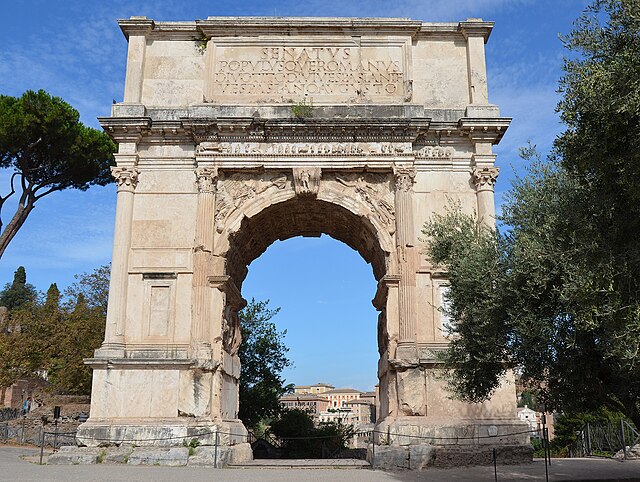The Wellington Arch, also known as the Constitution Arch or (originally) as the Green Park Arch, is a Grade I-listed triumphal arch by Decimus Burton that forms a centrepiece of Hyde Park Corner in central London, between the corner where Hyde Park meets Green Park. The Arch stands on a large green-space traffic island with crossings for pedestrian access. From its construction (1826–1830) the arch stood in a nearby location, slightly to the east, directly across from Burton's Ionic screen entrance to Hyde Park; it was moved a short distance to its current site at the top of the Constitution Hill road in 1882–1883. The triumphal arch originally supported a colossal equestrian statue of the 1st Duke of Wellington by the sculptor Matthew Cotes Wyatt, acquiring its name as a result. Peace descending on the Quadriga of War by sculptor Adrian Jones, a bronze of the Goddess of Victory Nike riding a quadriga, has surmounted the arch since 1912.
The Wellington Arch
1827 engraving showing the full ornamentation originally intended for the arch, including reliefs and statues. The engraving, from Thomas H. Shepherd's Metropolitan Improvements, was published while the arch was still under construction.
The Wellington Statue on the Arch in the 1850s. In its original configuration, the arch faced the screen entrance to Hyde Park, with Apsley House visible to the right. In the 1880s, the Arch was moved a short distance to the right of this picture and reoriented at the top of the Constitution Hill roadway. Atop the Arch, the statue was replaced with the Quadriga in 1912.
The quadriga
A triumphal arch is a free-standing monumental structure in the shape of an archway with one or more arched passageways, often designed to span a road, and usually standing alone, unconnected to other buildings. In its simplest form, a triumphal arch consists of two massive piers connected by an arch, typically crowned with a flat entablature or attic on which a statue might be mounted or which bears commemorative inscriptions. The main structure is often decorated with carvings, sculpted reliefs, and dedications. More elaborate triumphal arches may have multiple archways, or in a tetrapylon, passages leading in four directions.
The Triumphal Arch of Orange in Orange, France, the oldest surviving triple-arched Roman triumphal arch, probably built during the reign of Emperor Augustus (27 BC–14 AD), later reconstructed by emperor Tiberius (c. 20–27 AD)
The Arc de Triomphe, Paris, begun by Napoleon in 1806
The Arch of Titus in Rome, an early Roman imperial triumphal arch with a single archway, built c. 81 AD by Emperor Domitian to commemorate his brother Titus's victory together with their father, Vespasian, over the Jewish rebellion in Judaea
The Arch of Septimius Severus at Leptis Magna, Libya, a four-arched arcus quadrifrons, built c. 203 AD








